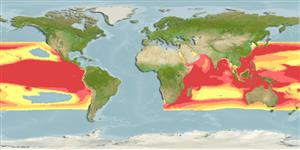Preferred temperature (Ref.
115969): 18.7 - 28.6, mean 26.7 (based on 2246 cells).
Phylogenetic diversity index (Ref.
82804): PD
50 = 0.7500 [Uniqueness, from 0.5 = low to 2.0 = high].
Bayesian length-weight: a=0.01047 (0.00411 - 0.02665), b=2.94 (2.72 - 3.16), in cm Total Length, based on LWR estimates for this (Sub)family-body shape (Ref.
93245).
ระดับชั้นอาหาร (Ref.
69278): 4.5 ±0.66 se; based on food items.
ความสามารถในการกลับคืนสู่ปกติ (Ref.
120179): ต่ำมาก, เวลาต่ำสุดที่จะทำให้ประชากรเพิ่มขึ้นเป็น 2 เท่าใช้เวลามากกว่า 14 ปี (Fec=2; tm=7-9; tmax = 29).
Prior r = 0.40, 95% CL = 0.26 - 0.60, Based on 2 full stock assessments.
Fishing Vulnerability (Ref.
59153): High to very high vulnerability (73 of 100).
